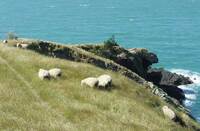- England
- Scotland
- France
- Holland
- Germany
- Italy
- Spain
- Portugal
- USA
- China
- Japan
- India
- Iran
- Advice
- Gardens
- England
- Scotland
- France
- Holland
- Germany
- Italy
- Spain
- Portugal
- USA
- China
- Japan
- India
- Iran
- Advice
- Garden Tours
Book: Landscape Planning and Environmental Impact Design: from EIA to EID
Chapter: Chapter 7 Agriculture, farming and countryside policy
Historic farmland can produce high-value 'hand-made' food. Methods which agricultural technologists regard as 'out-of-date' are often the only methods which can conserve the farming landscape. There is a lesson to be learned from the sea, where 'modern' industrial fishing is destroying the world's stock of wild fish. In Chesapeake Bay there is a law which requires oyster-dredging boats to be powered by sail (Safina, 1995). They are beautiful, quiet, non-polluting and very good for job creation. The principle can be applied to agriculture. Subsidies could be given to farmers on condition that they maintain farm walls, and use traditional farming methods. Simon Jenkins describes a conservative farm in Derbyshire: The meadows have never been deep ploughed. Windblown copses shelter a grateful population of voles and sparrows. Farm buildings date from 1700. When the Vesseys arrived to preserve all this in 1960, the soil had not been scarred by a single tractor... This is farming with a conscience, farming to make you feel good. (Jenkins, 1995) Jenkins sees this as 'a farm of the future... a symbol of the New Agriculture'. Such farms are likely to produce food with a significantly higher market value than industrial food. In Europe, this food comes from low intensity farming systems: the alpine pastures of Northern Italy, the grazing marshes on the Atlantic coast, the hay meadows of the Yorkshire Dales, the dryland wood pastures of western Spain (Baldock, 1994). Common Agricultural Policy money should be available for agricultural conservation, not intensification.

